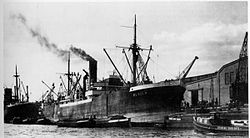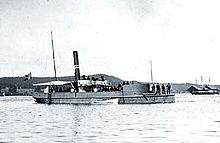Sao Paulo (ship, 1937)
|
The later Sao Paulo as Alrich
|
||||||||||||||||||||||||
|
||||||||||||||||||||||||
|
||||||||||||||||||||||||
|
||||||||||||||||||||||||
|
||||||||||||||||||||||||
The second Sao Paulo of the Hamburg-South American Steamship Company (HSDG) came in 1934 from North German Lloyd as Alrich in the shipping company's fleet.
In 1940 the Sao Paulo was used as a transporter for the Weser Exercise company . It belonged to the "export squadron " and was supposed to bring heavy equipment and supplies to the troops deployed for the conquest of Trondheim and to reach the port as early as possible after the occupation. The lone ship ran around midnight on April 9, 1940 in front of Bergen on a lock set up by the Norwegian mine- layer Tyr and sank.
History of the ship
The Sao Paulo was launched on December 14, 1921 as Glücksburg at the Schichau works in Danzig and was delivered to the Flensburger Dampfer Compagnie by Harald Schuldt on May 11, 1922 . The ship had been started as a speculative construction by the shipyard.
The Glücksburg was 110.26 m long and 15.68 m wide. The ship was measured with 4977 GRT with a load capacity of 7874 dwt. She was a conventional three-island ship with two masts. The drive was provided by a geared turbine of 1300 HPw, which enabled the Glücksburg to operate at a speed of 9 knots . The ship used in the Central America service had a crew of 39 and space for ten cabin passengers.
In 1925 the unsatisfactory turbine system was replaced by a triple expansion machine of 2600 PSi, which increased the service speed to 10 knots
Use until World War II
The Glücksburg was only in the service of the Flensburg shipping company to Central America for a good year. In July 1923 the ship was bought by the Bremen Roland-Linie and renamed Alrich . It was used in the shipping company's route to the west coast of South America. In the service of Roland, the drive system was changed at Blohm & Voss . From January 1, 1926, the ship then belonged to the North German Lloyd, which had incorporated the Roland Line. Initially used on the west coast, it was mainly used in Brazil from 1933 onwards.
In the course of the state reorganization of German shipping and its shipping areas, the NDL chartered the Alrich in 1934 to Hamburg-Süd, which eventually also acquired it. Altogether, the NDL had to hand over ten ships between 4565 and 8777 GRT built between 1911 and 1923. The Hamburg shipping company renamed the ship Sao Paulo in December 1937 ; However, Bremen remained the home port. At the beginning of the war in 1939, the Sao Paulo was on her way to La Plata in the Central Atlantic and then called at Pernambuco .
War effort
In mid-November 1939 the ship moved to Cabedelo in Brazil , where she stayed for the time being. At the beginning of 1940, a number of German ships that lay in Brazil tried to escape to Germany. One of them was Sao Paulo , which left Brazil on January 8th and arrived in Hamburg on March 3rd, 1940 after successfully breaking through the blockade over Norway.
The Sao Paulo was immediately used as a transporter for Operation Weser Exercise - the German occupation of Norway. She was assigned to the "export squadron " that was supposed to transport the heavy equipment of the first landing units.
Late in the evening of April 4, the Sao Paulo left Brunsbüttel several hours before the other two transporters, the Main (7624 BRT) and Levante (4769 BRT) intended for Trondheim , in order to reach its destination in time. The three self-propelled transporters were to transport eight Czech 10 cm howitzers for two motorized artillery batteries, eight 8.8 cm anti-aircraft guns for two batteries and 18 20 mm anti-aircraft guns for one motorized unit, as well as an airfield company and other military goods.
For technical reasons, the Sao Paulo arrived in Kristiansand on April 7th . Since a punctual arrival in Trondheim could no longer be expected, the steamer was diverted to Bergen. On the 9th, shortly before midnight , the Sao Paulo ran near Brattholm on a mine barrier laid by Norwegian mine- layers Uller (built in 1876) and Tyr (built in 1887) and received two mine hits . The ship sank in half an hour at the position 60 ° 20 '8 " N , 5 ° 11' 30" O . Seven men died; the survivors were rescued by the Cremon fish steamer and taken to Bergen.
Individual evidence
- ↑ a b c d e f g h A. Kludas: The ships of Hamburg-Süd 1871–1951. 1976, p. 110.
- ↑ a b c d A. Kludas: The ships of the North German Lloyd 1920-1970. Volume 2, 1992, p. 44.
- ^ A. Kludas: The ships of Hamburg-Süd 1871–1951. 1976, pp. 109-115.
- ↑ Fish steamer Cremon (1923, 235 GRT) on the way out to fish in the Barents Sea, got into a German minefield and sank the next day while searching for the Norwegian barrier due to navigation errors, only five survivors
Web links
- Use of Sao Paulo
- Sinking of the Sao Paulo
- Wreck of the Sao Paulo
- TK Derry: THE CAMPAIGN IN NORWAY
- NAVAL EVENTS, APRIL1940 (Part 2 of 4)
- Equipment Transport Echelon ( Memento from November 10, 2013 in the Internet Archive )
literature
- Arnold Kludas : The ships of Hamburg-Süd 1871–1951. Verlag Gerhard Stalling, Oldenburg 1976, ISBN 3-7979-1875-5 .
- Arnold Kludas: The ships of the North German Lloyd 1920-1970. Koehlers Verlagsgesellschaft, Herford 1992, ISBN 3-7822-0534-0 .
- Jürgen Rohwer , Gerhard Hümmelchen : Chronicle of the naval war 1939-1945. Verlag Manfred Pawlak, Herrsching 1968, ISBN 3-88199-009-7 .
- Reinhardt Schmelzkopf: German merchant shipping 1919–1939. Volume 1: Chronicle and evaluation of the events in shipping and shipbuilding. Gerhard Stalling, Oldenburg 1974, ISBN 3-7979-1847-X .
- Trygve Sandvik: Krigen i Norge 1940 - Operasjonene til lands i Nord-Norge 1940. 2 volumes. Forsvarets Krigshistoriske Avdeling / Gyldendal Norsk Forlag, Oslo 1965.
- Erik Anker Steen: Norge sjøkrig 1940–1945 - Sjøforsvarets kamper og virke i Nord-Norge 1940. Forsvarets Krigshistoriske Avdeling / Gyldendal Norsk Forlag, Oslo 1958.

